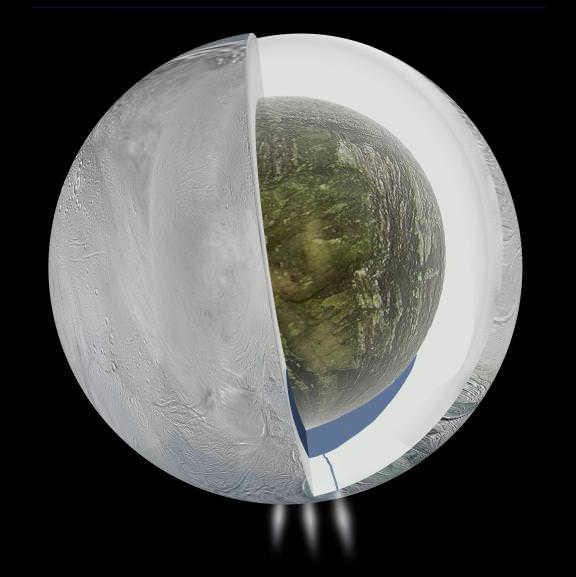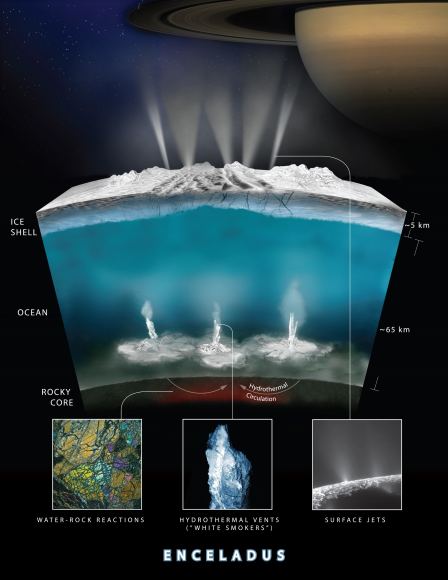Skip to comments.
New Study Says Enceladus has had an Internal Ocean for Billions of Years
Universe Today ^
| 11/06/2017
| Matt Williams
Posted on 11/09/2017 7:14:52 PM PST by BenLurkin
The study, titled “Powering prolonged hydrothermal activity inside Enceladus“, recently appeared in the journal Nature Astronomy. The study was led by Gaël Choblet, a researcher with the Planetary and Geodynamic Laboratory at the University of Nantes, and included members from NASA’s Jet Propulsion Laboratory, Charles University, and the Institute of Earth Sciences and the Geo- and Cosmochemistry Laboratory at the University of Heidelberg.
...
Based on the way Enceladus orbits Saturn with a certain wobble (aka. libration), scientists have been able to make estimates of the ocean’s depth, which they place at 26 to 31 km (16 to 19 mi). All of this surrounds a core which is believed to be composed of silicate minerals and metal, but which is also porous. Despite all these findings, the source of the interior heat has remained something of an open question. This mechanism would have to be active when the moon formed billions of years ago and is still active today (as evidenced by the current plume activity). As Dr. Choblet explained in an ESA press statement:
“Where Enceladus gets the sustained power to remain active has always been a bit of mystery, but we’ve now considered in greater detail how the structure and composition of the moon’s rocky core could play a key role in generating the necessary energy.”
(Excerpt) Read more at universetoday.com ...
TOPICS: Science
KEYWORDS: astronomy; enceladus; geysers; saturn
 Gravity measurements by NASA’s Cassini spacecraft and Deep Space Network suggest that Saturn’s moon Enceladus, which has jets of water vapor and ice gushing from its south pole, also harbors a large interior ocean beneath an ice shell, as this illustration depicts.
Gravity measurements by NASA’s Cassini spacecraft and Deep Space Network suggest that Saturn’s moon Enceladus, which has jets of water vapor and ice gushing from its south pole, also harbors a large interior ocean beneath an ice shell, as this illustration depicts.
Credit: NASA/JPL-Caltech
1
posted on
11/09/2017 7:14:52 PM PST
by
BenLurkin
 Artist rendering showing an interior cross-section of the crust of Enceladus, which shows how hydrothermal activity may be causing the plumes of water at the moon’s surface.
Artist rendering showing an interior cross-section of the crust of Enceladus, which shows how hydrothermal activity may be causing the plumes of water at the moon’s surface.
Credits: NASA-GSFC/SVS, NASA/JPL-Caltech/Southwest Research Institute
2
posted on
11/09/2017 7:16:24 PM PST
by
BenLurkin
(The above is not a statement of fact. It is either satire or opinion. Or both.)
To: BenLurkin
3
posted on
11/09/2017 7:18:01 PM PST
by
Dr. Bogus Pachysandra
(Don't touch that thing Don't let anybody touch that thing!I'm a Doctor and I won't touch that thing!)
To: BenLurkin
Enceladus can give you some nasty acid reflux.
4
posted on
11/09/2017 7:20:28 PM PST
by
rfp1234
(I have already previewed this composition.)
To: BenLurkin
Erudite fools foaming at the mount. Silly nonsense with the standard evolutionary nonsense. Prove it!
5
posted on
11/09/2017 7:25:05 PM PST
by
Fungi
(What the hell is a fungus?)
To: BenLurkin
6
posted on
11/09/2017 7:25:23 PM PST
by
Zuse
(I am disrupted! I am offended! I am insulted! I am outraged!)
To: rfp1234
7
posted on
11/09/2017 7:26:37 PM PST
by
sparklite2
(-)
To: BenLurkin
Theoreticians using computer models and mathematics will never solve the fundamental mysteries of our universe. They’re essentially guessing about what makes the cosmos tick.
8
posted on
11/09/2017 7:30:52 PM PST
by
Windflier
(Pitchforks and torches ripen on the vine. Left too long, they become black rifles.)
To: Zuse
Electric Universe makes more sense. Indeed, it does. By orders of magnitude.
9
posted on
11/09/2017 7:33:30 PM PST
by
Windflier
(Pitchforks and torches ripen on the vine. Left too long, they become black rifles.)
To: BenLurkin
Enceladus has an internal ocean of molten cheese.
The crust around it is made of onions and jalapenos.
It’s only natural that it lets off a little gas at the south pole.
10
posted on
11/09/2017 7:56:07 PM PST
by
TigersEye
(0bama. The Legacy is a lie. The lie is the Legacy.)
To: BenLurkin
Did the moon first start off as rocky with no water? If so how did all that water stay when the core heating would drive it off? So heres a cold surface with hot water underneath...so hot it cracks the ice and pooches through...now how long can that last before all the waters evaporate? Where did the water come from? Did the comets only hit this moon? Does this moon have an atmosphere? Too many questions...
11
posted on
11/09/2017 9:35:15 PM PST
by
Getready
(Wisdom is more valuable than gold and diamonds, and harder to find)
To: Zuse; 1FreeAmerican; AFreeBird; A. Patriot; AndrewC; antonia; aristotleman; Art in Idaho; ...
Gravity consensus cosmologists straining at gnats trying to explain Enceladus perpetual polar plumes when Electric Universe has a far better and non-straining explanation that fits all the observed facts.

If you want on or off the Electric Universe Ping List, Freepmail me.
12
posted on
11/10/2017 12:40:49 AM PST
by
Swordmaker
(My pistol self-identifies as an iPad, so you must accept it in gun-free zones, you racist, bigot!)
To: Zuse
From the article:
However, the energy produced by tidal friction in the ice is too weak to counterbalance the heat loss seen from the ocean. At the rate Enceladus’ ocean is losing energy to space, the entire moon would freeze solid within 30 million years.
They need to go from the under ice ocean freezing solid in under 30 million years to lasting for billions of years AND replenishing the e-ring. . . So they toss out gravity compressed rock to create an ad hoc planetary core of loose gravel and metal material for water to seep into which tidal friction then grinds together heating the water to above the 0° Celsius, keeping the entire ocean hot enough to avoid freezing, but some is hot enough to reach 100° C and works way through miles of cooler water, retaining its vaporous State, then forces its way through several miles of ice to form jets of water vapor and ice crystals. . . Right, sure, there’s nothing wrong with this hypothesis. Have they not seen the chaotic flow of boiling water mixed with cooler water and measured the resulting temperature of the mix? Or did some postulated Encaladan natives build huge vents to the surface for their planetary water conditioning system?
13
posted on
11/10/2017 1:00:32 AM PST
by
Swordmaker
(My pistol self-identifies as an iPad, so you must accept it in gun-free zones, you racist, bigot!)
To: BenLurkin
So many arguments - which can be healthy - but seek to counter the basic science by which engineers had put the spacecraft there to begin with.
Of course the electron-proton interaction is electrical. Though gravity being so much weaker, takes up an ever more significant role in such massive environments.
14
posted on
11/10/2017 7:49:24 AM PST
by
onedoug
To: TigersEye
To: Boogieman
The asteroid belt is actually made of tortilla chips ... so we’ll make a stop there first.
16
posted on
11/10/2017 1:51:32 PM PST
by
TigersEye
(0bama. The Legacy is a lie. The lie is the Legacy.)
To: TigersEye
And there's always the Milky Way for dessert.
17
posted on
11/10/2017 1:56:34 PM PST
by
4yearlurker
(We live in deeds, not years, in thoughts, not breaths.)
To: 4yearlurker
We might have to loosen Orion’s belt before the trip is over!
{burp} Pardon me.
18
posted on
11/10/2017 2:02:15 PM PST
by
TigersEye
(0bama. The Legacy is a lie. The lie is the Legacy.)
Disclaimer:
Opinions posted on Free Republic are those of the individual
posters and do not necessarily represent the opinion of Free Republic or its
management. All materials posted herein are protected by copyright law and the
exemption for fair use of copyrighted works.
FreeRepublic.com is powered by software copyright 2000-2008 John Robinson



